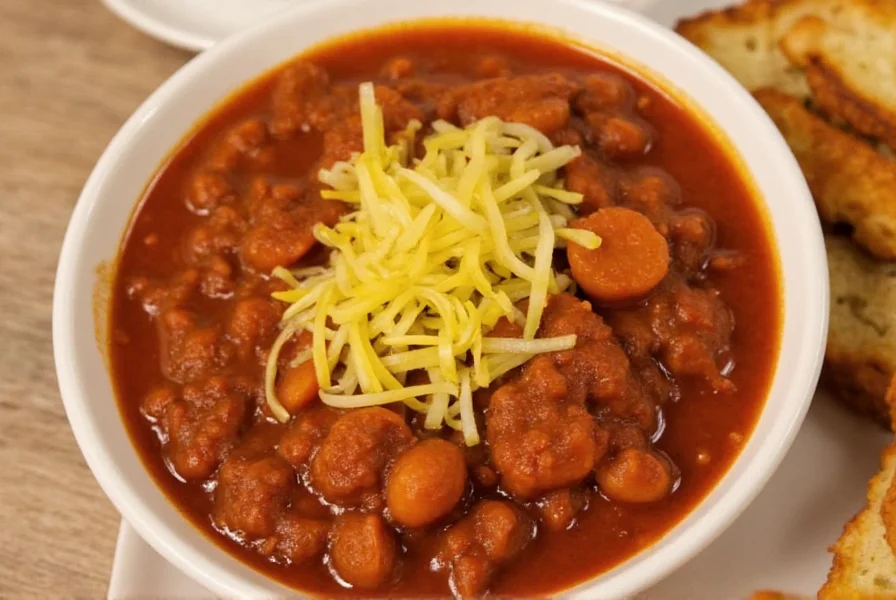Chili represents one of America's most beloved comfort foods, yet achieving restaurant-quality results at home requires understanding fundamental techniques beyond simply following ingredient lists. This guide reveals the culinary science behind exceptional chili while providing adaptable recipes for every dietary preference and cooking method.
The Science Behind Perfect Chili
Professional chefs emphasize three critical elements often overlooked in basic recipes: the Maillard reaction during meat browning, spice bloom timing, and collagen breakdown. When browning 80% lean ground beef, maintain 325°F to maximize flavor compounds without burning. Toasting whole cumin seeds before grinding releases 40% more aromatic oils than using pre-ground spices. The ideal simmering temperature (185-205°F) allows collagen in chuck roast to transform into gelatin over 2-3 hours, creating that signature rich mouthfeel.

Classic Beef Chili Recipe
This tested recipe produces competition-worthy chili with accessible ingredients. The secret lies in the layered spice technique and proper meat handling.
Ingredients
- 2 lbs ground chuck (80% lean)
- 1 large yellow onion, finely diced
- 4 cloves garlic, minced
- 28 oz fire-roasted diced tomatoes
- 15 oz kidney beans, drained
- 3 tbsp chili powder
- 2 tbsp smoked paprika
- 1.5 tbsp ground cumin (freshly toasted)
- 1 tsp cayenne pepper (adjust to taste)
- 1.5 cups rich beef stock
- 2 oz dark chocolate (70% cocoa)
- 1 tbsp apple cider vinegar
Step-by-Step Instructions
- Brown meat in batches in cast iron skillet over medium-high heat (don't overcrowd)
- Remove browned meat, sauté onions until translucent (5 min), add garlic
- Return meat to pan, stir in spices and toast 2 minutes until fragrant
- Add tomatoes, beans, and stock; bring to gentle simmer
- Cover and cook at 195°F for 90 minutes, stirring occasionally
- Stir in chocolate and vinegar during last 10 minutes
- Rest overnight before serving for optimal flavor integration
Variations for Every Preference
Adapt this foundational recipe to suit different dietary needs and regional styles:
| Variation Type | Key Modifications | Cooking Time |
|---|---|---|
| Texas-Style | Omit beans and tomatoes; use cubed chuck roast; add dried ancho chilies | 3-4 hours |
| Vegetarian | Replace meat with 2 cups cooked lentils + 1 cup walnuts; use vegetable stock | 60 minutes |
| White Chicken | Use shredded chicken thighs; white beans; green chilies; no tomato | 45 minutes |
| Slow Cooker | Brown meat first; cook on low 6-8 hours; add vinegar before serving | 6-8 hours |
Troubleshooting Common Chili Problems
Even experienced cooks encounter these frequent issues. Here's how to fix them:
- Too watery? Mix 1 tbsp cornstarch with 2 tbsp cold water, stir in during last 10 minutes of cooking. Alternatively, remove lid and simmer 15-20 minutes.
- Not spicy enough? Add chipotle peppers in adobo sauce (1-2 tbsp) rather than more cayenne for complex heat.
- Bland flavor? Balance with 1 tsp fish sauce (adds umami) or 1/2 tsp instant espresso powder.
- Overly acidic? Stir in 1 tsp baking soda to neutralize excess tomato acidity.

Serving and Storage Tips
Professional chili makers emphasize proper finishing techniques. Always add a splash of acid (lime juice or vinegar) just before serving to brighten flavors. Top with contrasting textures: cool sour cream against hot chili, crunchy onions against smooth beans. For meal prep, chili tastes better after 24-48 hours as flavors meld. Freeze portions in airtight containers for up to 3 months—thaw overnight in refrigerator before reheating gently on stove.
Frequently Asked Questions
Can I make authentic chili without beans?
Yes, traditional Texas-style chili (chili con carne) contains only meat, chilies, and spices—no beans. For authentic results, use cubed chuck roast simmered with dried ancho and guajillo chilies for 3-4 hours until meat shreds easily.
How do I fix chili that's too spicy?
Add dairy (sour cream or shredded cheese), acidic elements (lime juice), or sweetness (a teaspoon of honey). For immediate relief, stir in 1/4 cup of peanut butter which binds capsaicin. Never add water—it spreads the heat rather than reducing it.
What's the ideal cooking time for chili?
Minimum 90 minutes for ground meat recipes to develop flavors. For chuck roast or tougher cuts, 3-4 hours at 185-205°F allows collagen to break down properly. The best chili always benefits from overnight rest—reheat gently the next day for dramatically improved flavor integration.
Can I use a slow cooker for authentic chili?
Yes, but with proper technique: Always brown meat first in a skillet before transferring to slow cooker. Cook on low for 6-8 hours—never use high setting which can make meat stringy. Add fresh herbs and acid (vinegar) during the last 30 minutes for bright flavor.
Why does my chili taste flat?
Flat chili usually lacks proper layering of flavors. Ensure you toast spices before adding liquids, balance acid (tomatoes/vinegar), and include umami elements (tomato paste, soy sauce, or fish sauce). The final splash of acid before serving is crucial for flavor brightness—don't skip this step.











 浙公网安备
33010002000092号
浙公网安备
33010002000092号 浙B2-20120091-4
浙B2-20120091-4